Note: scroll to the bottom of the page for a glossary of tomato terminology.
Amish Paste:
Average days to maturity: 85
Open-pollinated, heirloom
Indeterminate
Amish Paste is big for a paste tomato – I’ve had some top out at over 1 pound, though usually they’re more like 8 ounces. In this photo, I’ve posed them next to Sun Gold cherry tomatoes, so you can get a sense of their heft. They’re fairly late to mature and they need good nutrition, water and space to produce their best fruits.
An heirloom that dates back to the 1870s, Amish is very meaty without many seeds. It’s not meant for fresh eating, but is excellent for sauce, canning, roasting and freezing.
Black Cherry:
Average days to maturity: 75
Open-pollinated
Indeterminate
Black Cherry is a very productive variety that will go on ripening fruit until hard frost cuts the plant down. Its fruits are large (as cherry tomatoes go), juicy-tangy and a soft shade of purple.
Black Krim
Average days to maturity: 80
Open-pollinated, heirloom from the Ukraine
Indeterminate
Black Krim is one of my favorite tomatoes, with a rich, smoky-sweet flavor. Fruits are large, usually just over or just under 1 pound, and subject to cat-facing. Pick them when they still have green shoulders but the rest of the fruit is dark purple.
Bobcat Tomato
Days to maturity: 65
Hybrid
Indeterminate
I grew these for the first time last year and found them to take longer than 65 days to mature. That said, this hybrid produced nice, red, juicy 6-10 ounce tomatoes with a flavor that was well-balanced between sweet and acid.
Bulgarian Heart
Average days to maturity: 75
Open-pollinated
Indeterminate
This beautiful oxheart tomato was given to me by a friend who had been in the Peace Corps in Bulgaria and who was yearning for tomatoes like the ones she ate there. The seeds were sent to my friend by a friend of hers in Bulgaria in the early 2000s. They came in a commercial seed packet, but didn’t seem to have a variety name, just a generic description in Bulgarian. I have grown these and saved the seeds from them ever since. They begin producing mid-season and have three or four big flushes of fruit before frost finally takes them down. They are good to cook with or to eat fresh and, as you can see, are lovely to look at. That said, the plant seems susceptible to disease and always looks too scraggly to produce so much fruit.
Casady’s Folly Paste
Average days to maturity: 85
Open-pollinated
Determinate
This variety was developed by Tom Wagner, who also developed Speckled Roman Paste. Both have a brilliant red background and thin marigold orange stripes. Casady’s Folly is very long, thin and meaty and made good sauce. I did not find the plant to be as productive as Speckled Roman, though, even though it is supposed to be less susceptible to disease. I’ll try it again in a new spot and see how it does.
Egg Yolk Cherry
Average days to maturity: 78
Open-pollinated
Indeterminate
Egg Yolk produces lots of small chartreuse cherry tomatoes over a long period, producing right up to frost. A little tarter and less complex than I like, but they look and taste great in salsa.
Gajo de Melon Cherry
Average days to maturity: 80
Open-pollinated
Indeterminate
Gajo de Melon is a large cherry tomato, with a golden yellow base color blushed with rose and a little green. It is very pretty and productive, though I find the fruit to be less flavorful than most other cherry tomatoes.
Goldie
Average days to maturity: 80
Open-pollinated
Indeterminate
I’ve trimmed 10 days off the a.d.m. for Goldie because in my garden and unheated greenhouse my Goldie’s are always some of the first big tomatoes to come ripe, and then continue ripening large trusses of large fruit every few weeks until frost. Goldie is a gorgeous yellow-orange tomato, meaty flesh, and a good, balanced sweet flavor. The fruits can get very large – over a pound – and will sometimes “catface,” especially the earliest fruits that set when the weather was still cool and the pollinators erratic.
Green Zebra
Average days to maturity: 75
Open-pollinated, introduced by Tom Wagner in 1985
Indeterminate
Green Zebra is not very big, averaging only 4 or 5 ounces, but it’s fairly early, prolific and healthy (though it is reputed to be susceptible to septoria leaf spot). Grafted to Maxifort rootstock, it was probably the most productive tomato in my greenhouse, though it also grew well outside on its own roots in my garden. Once it gets going, it doesn’t stop until frost mows it down.
 Green Zebra is a spritely, happy little tomato, both in looks and taste. When ripe, the skin color mellows, glowing gold in the background and etched with bright green stripes in the foreground. Inside, the fruit has a whitish core surrounded by green apple flesh. The seed pockets are filled with a tart green gel that makes for refreshing eating, a nice balance between sweet and sour.
Green Doctors Frosted Grape
Average days to maturity: 80
Open-pollinated, discovered by Amy Goldman 2002
Indeterminate
Green Doctors Frosted was introduced by tomato expert Amy Goldman who found it growing as a sport from a “Dr. Carolyn” tomato plant. This is a large grape – at least two bites. Healthy, productive plants.
Honey Bunch Red Grape
Average days to maturity: 45
Hybrid
Indeterminate
Let these get really red before harvesting for sweetest tomatoes. These have a nice snap when you bite into them. They produce large trusses on a healthy, early ripening and long standing plant.
Jubilee
Average days to maturity: 80
Open-pollinated
Indeterminate
Jubilee is the Marilyn Monroe of tomatoes – voluptuous, gorgeous, perfect looking. The fruits will be about 1/2 pound, with silky yellow-orange skin, sweet and meaty.
Lucia Grape
Average days to maturity: 54
Hybrid
Indeterminate
Early, productive, big trusses of tart-sweet red grape tomatoes with a nice snap to the skin.
Orange Banana Paste
Average days to maturity: 85
Open-pollinated
Indeterminate
Orange Banana is a good, sweet paste tomato with a lovely calendula color that makes wonderful sauce and is good for drying. It ripens latish,and is a pretty good producer of 4-5 ounce fruits. Though honestly, my sister-in-law, who puts about a foot of well-rotted horse manure on her garden every year, gets scads more of these than I do, so I’m guessing they like things rich.
They’re also a little susceptible to blossom-end rot, which means you need to irrigate them well during dry spells (though blossom-end rot is caused by a calcium deficiency, that deficiency often occurs because the plants aren’t getting enough water).
Mr. Fumarole Paste
Average days to maturity: 65
Open-pollinated
Indeterminate
Also known as “Mr. Fumo,” though this variety isn’t terribly productive, the tomatoes stand up to drought well, and are resistant to blossom end rot. Good flavor.
Old German Striped
Average days to maturity: 85
Open-pollinated, heirloom
Indeterminate
This tomato of many colors was sent to me one year as a replacement when Fedco Seeds ran out of my personal favorite, Pineapple. Old German is a lot like Pineapple – enormous, sweet, late-season and a gorgeous mixture of orange, yellow and red. The one difference I noticed was Old German seems more striped than Pineapple. Also, Old German had a bit of green streaking on the exterior skin along with the warm tones, which I’ve never noticed in Pineapple. Reportedly a 19th Century Mennonite introduction.
Pineapple
Average days to maturity: 85
Open-pollinated, heirloom
Indeterminate
Pineapple is my favorite tomato. Her flavor is sweet and fruity with enough tang so you know you’re eating a tomato. Pineapple also has smooth, delectable flesh and plenty of juice.
Though Pineapple will cat-face and crack when the weather isn’t ideal, a well grown Pineapple is one of the most beautiful tomatoes around. Her skin is striped orange and red on a yellow background, and on the inside Pineapple does bear a passing resemblance to the fruit, with lots of triangular seed pockets. Her interior color is even better than the exterior color, with swirls of cantaloupe and watermelon and streaks of red and orange over the yellow.
She’s huge, often topping a pound, which means she’s also pretty late. That said, Pineapple will keep producing up until frost. This is a tomato that will make you sigh with delight, I promise.
Pink Icicle Paste
Average days to maturity: 80
Open-pollinated, originated in Russia, introduced by Baker Creek Seeds
Indeterminate
I have found the “Icicle” series (it also includes Orange Icicle and Black Icicle) to be easy to grow and fairly productive. Though it can be slow to start, late in the season Pink Icicle becomes very productive. Barring an early frost, September is when this tomato is most fruitful.
Premio
Average days to maturity: 60
Hybrid
Indeterminate
Though Premio is supposed to be an early tomato, I have found that it doesn’t really get going until late in the season. When open-pollinated tomatoes are succumbing to late season diseases, Premio begins producing clusters of 4 ounce tomatoes, all identical, flawless and quite juicy and flavorful.
Riesentraube Grape
Average days to maturity: 80
Open-pollinated, heirloom from Germany
Indeterminate
Riesentraube prduces big clusters of small pointy-tipped tomatoes. They are juicy and tart-sweet and a bit thin-skinned. The plants never get very large in my gardens and greenhouse, but they are very productive, particularly late in the season.
San Diego Paste
Average days to maturity: 64
Hybrid
Determinate
I grew San Diego for the first time last year and was really impressed. In my unheated greenhouse, San Diego produced lots and lots of big, solid paste tomatoes. And though it’s supposed to be determinate, I found it productive over a long period, finishing with a bumper crop in early September. Very disease resistant, fruits are excellent for sauce.
Speckled Roman Paste
Average days to maturity: 85
Open-pollinated
Indeterminate
I have a real fondness for Speckled Roman because it’s the first striped tomato I ever grew. It’s also a good paste tomato, about 4 or 5 ounce ones, sweet and nice for sauce and roasting.
That said, in my cold garden it’s pretty disease-prone, especially when it’s wet. Still, even when it’s looking bedraggled, it’s fairly productive. Look for Speckled Romans to begin as a trickle mid-season followed by lots and lots late- season.
I feel like I’ve been growing it forever, so I was surprised to read in my Fedco catalogue that it was born the same year as Google, 1998. Developed by John Swenson, Speckled Roman is the love-child of Banana Legs and Antique Roman.
Glossary
“Average days to maturity” is the number of days you should expect to wait before you’ll see ripe fruit. This number assumes you started seedlings indoors 4-6 weeks before the last frost in your area, and then transplanted the seedlings outside when there was no longer any danger of frost. The number of days is counted from transplant date (not seed starting date).
For example, if I transplanted an Amish Paste seedling into the garden on June 1, I would expect to begin harvesting ripe Amish Paste tomatoes 85 days later, in late August.
“Open-pollinated” means that the variety is genetically stable and that seeds saved from the variety will grow the same kind of tomato the next year.
“Heirloom” means that a variety is not only open-pollinated, but it is also an old variety preserved by generations of seed savers.
“Hybrid” varieties are created by cross-pollinating different tomato varieties to create a new variety. Hybridization is used to create plants that have desirable qualities, such as uniformity and disease resistance. Hybrids are generally not genetically stable; if you save seeds from hybrid tomatoes and plant them the next year, the second generation tomatoes will probably be quite different from the parent plants.
“Determinate” versus “Indeterminate:” Determinate tomatoes grow to a certain size then stop growing. They usually ripen all their fruit at the same time, which makes them convenient for canning and freezing. Indeterminate tomatoes never stop growing until they are cut down by cold or disease. They produce their fruit over a long period of time and will continue flowering and ripening new tomatoes until frost. Because indeterminate tomatoes can grow quite large, they are usually supported in some fashion, such as stakes or cages.
“Paste” tomatoes (also called “plum,” “pear,” “processing” and “saladette”) are generally meant for cooking and canning. They tend to be less juicy and have fewer seeds than fresh eating tomatoes. Sometimes they have a mealy mouth-feel that is unpleasant for fresh eating but that works well in cooking. They are often shaped differently than a fresh eating tomato, growing in elongated “plum” or “pear” shapes. Many paste tomatoes are determinate growers, which is handy if you want to concentrate your canning efforts.
“Cherry” and “Grape” tomatoes produce small, usually bite-sized fruits, often in tresses that ripen almost all at once. They tend to be quite sweet, early and productive and will often grow into enormous indeterminate plants.
“Beefsteak” tomatoes are the opposite of cherry and grape tomatoes. These fruits are huge, sometime topping two pounds. One slice of a beefsteak will cover a slice of bread, which makes them great for sandwiches.

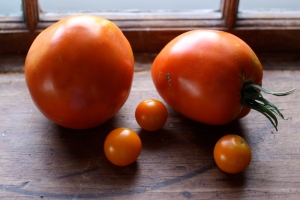
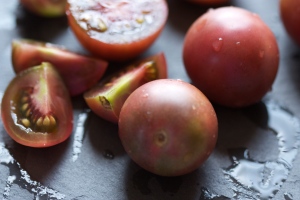
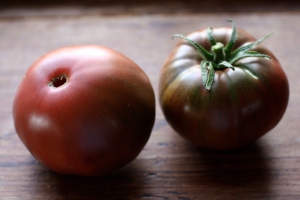





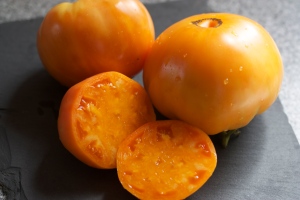




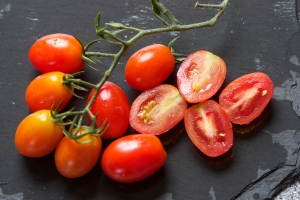
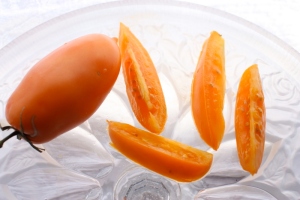
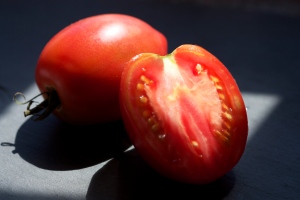


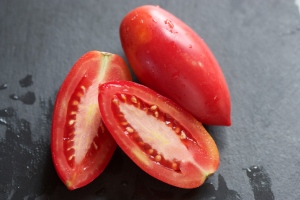




Pingback: Lots More on Tomatoes | Cold Garden Warm Kitchen